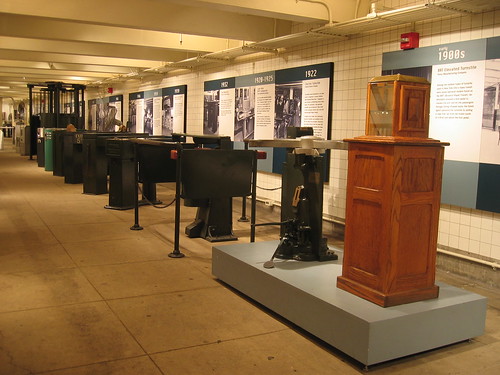
A 1939 map of the BMT shows the now-forgotten Myrtle Ave. stop on the edge of the Manhattan Bridge. (Courtesy of NYC Subway Historical Maps)
Before the spate of Second Ave. subway news hit, we were talking about the Masstransiscope in the remains of the old, abandoned Myrtle Ave. stop on the BMT line that runs over the Manhattan Bridge. Abandoned stations hide the mysteries and romance of a lost age in New York City history, and the Myrtle Ave. stop is no different.
For those living in Brooklyn, sick of seeing the N and D glide past the middle tracks at De Kalb Ave. when the R, Q or B just won’t show up, the Myrtle Ave. stop contains the promise, however slim, of an added stop in Brooklyn. For others, this abandoned stop is a playground within the subway. Can we go off on an expotition and romp around the empty platforms?
Nowadays, we can, as NY1 finally reported two weeks after I did, view the old City Hall stop from the 6 as it turns on that steep curve, but the Myrtle Ave. stop is one lost to time.
For starters, the southbound platform at Myrtle Ave. was completely demolished after the station went out of service in 1956. But why the changes? Joseph Brennan, an expert on abandoned stations, explains:
The De Kalb Ave section was the choke point for the entire BMT Broadway subway operation, with a lot of merges and some routings crossing others at grade in the swiches on both sides of the station. The maximum train capacity of the system was set here. After decades of problems, the Transit Authority began a rebuild of the area in 1956, adding some new trackage to eliminate all the grade crossings and provide places to hold trains approaching merge points.
Myrtle Ave station was a casualty of the rebuild. A new track had to be added on the west side to allow for a grade-separated crossing. The original southbound “local” track at the platform had to be depressed to a lower grade to cross under, and the new track wiped out the southbound platform. The northbound platform was left in place but no longer operated.
Still something of a choke point on the system — how many folks sit on a B train while a D crosses in front and how many wish the trains wouldn’t crawl coming down off the bridge — imagine how much worse it could be. To streamline the N and D trains as they bypass De Kalb on the express tracks and head either onto the Manhattan Bridge or into Pacific Street, the Myrtle Ave. southbound platform had to go.
Still, the northbound platform sits abandoned and covered in graffiti. It can no longer be used because the platform is shorter than the long BMT trains now in use. Furthermore, as frequent commenter Peter noted on Monday, the City is allowing a developer who recently purchased the block above the old Myrtle Ave. platform to demolish the access points to the old station. The only way to reach Myrtle Ave., a relic of the early 20th Century subway system, will be through the incredibly dangerous tunnels north of De Kalb Ave.
So the dreams of an abandoned station will go die. Like the ghost stop in front of my parents’ apartment building on West 91st St., the Myrtle Ave. station has lain dormant for 50 years. Soon, all we’ll see are glimpses of a platform through an abandoned zoetrope, and riders will forever wonder just what it was they fleetingly saw out the window.









 That sound you hear, it’s not a dance troupe practicing its tap routine. No, instead, it’s MTA CEO Elliot “Lee” Sander tangoing around the thorny issue of a fare hike in 2008.
That sound you hear, it’s not a dance troupe practicing its tap routine. No, instead, it’s MTA CEO Elliot “Lee” Sander tangoing around the thorny issue of a fare hike in 2008.